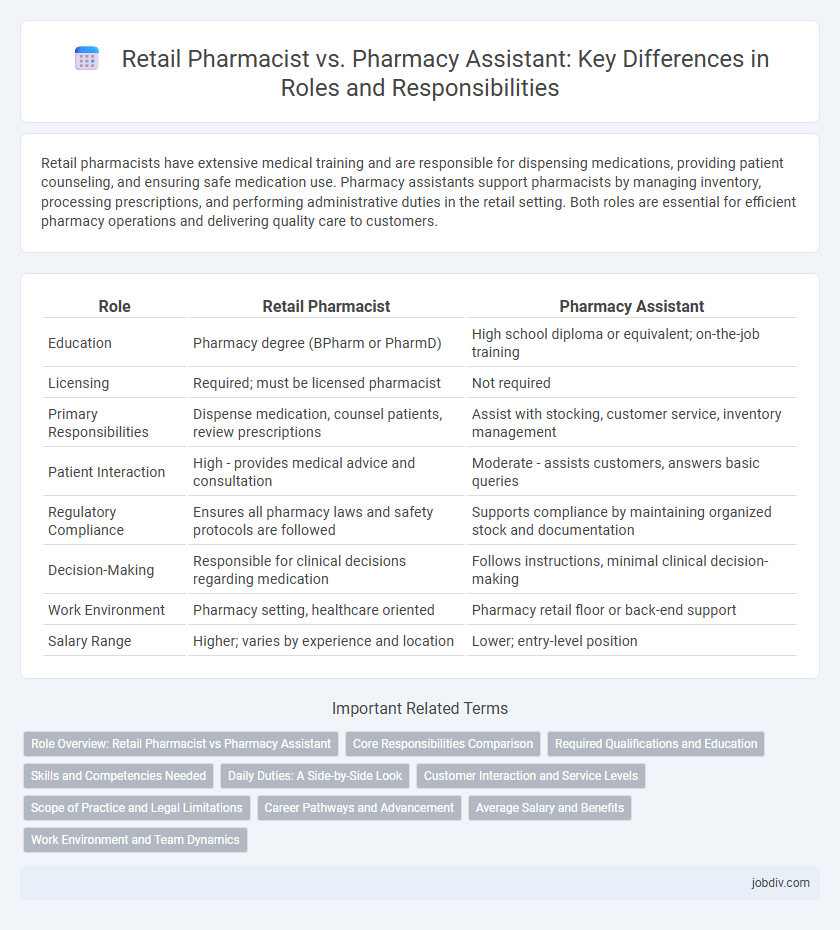Retail pharmacists have extensive medical training and are responsible for dispensing medications, providing patient counseling, and ensuring safe medication use. Pharmacy assistants support pharmacists by managing inventory, processing prescriptions, and performing administrative duties in the retail setting. Both roles are essential for efficient pharmacy operations and delivering quality care to customers.
Table of Comparison
| Role | Retail Pharmacist | Pharmacy Assistant |
|---|---|---|
| Education | Pharmacy degree (BPharm or PharmD) | High school diploma or equivalent; on-the-job training |
| Licensing | Required; must be licensed pharmacist | Not required |
| Primary Responsibilities | Dispense medication, counsel patients, review prescriptions | Assist with stocking, customer service, inventory management |
| Patient Interaction | High - provides medical advice and consultation | Moderate - assists customers, answers basic queries |
| Regulatory Compliance | Ensures all pharmacy laws and safety protocols are followed | Supports compliance by maintaining organized stock and documentation |
| Decision-Making | Responsible for clinical decisions regarding medication | Follows instructions, minimal clinical decision-making |
| Work Environment | Pharmacy setting, healthcare oriented | Pharmacy retail floor or back-end support |
| Salary Range | Higher; varies by experience and location | Lower; entry-level position |
Role Overview: Retail Pharmacist vs Pharmacy Assistant
Retail pharmacists are licensed healthcare professionals responsible for dispensing medications, providing medication counseling, and ensuring patient safety through proper drug interactions and dosage verification. Pharmacy assistants support pharmacists by managing inventory, preparing prescriptions under supervision, and handling customer service tasks such as processing payments and answering routine inquiries. The pharmacist's role centers on clinical expertise and regulatory compliance, whereas the pharmacy assistant focuses on operational efficiency and customer support within the retail pharmacy setting.
Core Responsibilities Comparison
Retail pharmacists are responsible for dispensing medications, ensuring prescription accuracy, and providing patient counseling on drug usage and potential side effects. Pharmacy assistants primarily support pharmacists by managing inventory, preparing prescription labels, and handling customer service tasks. Both roles are essential for efficient pharmacy operations, but pharmacists require extensive pharmaceutical knowledge and licensing.
Required Qualifications and Education
Retail pharmacists require a Doctor of Pharmacy (Pharm.D.) degree and must pass licensing exams such as the NAPLEX to practice independently, ensuring advanced knowledge in medication therapy and patient care. Pharmacy assistants typically need a high school diploma or equivalent and may complete certificate programs, gaining skills in inventory management and customer support without the extensive clinical training mandated for pharmacists. The difference in qualifications reflects the distinct responsibilities, with pharmacists addressing complex drug interactions and pharmacy assistants supporting daily operations under supervision.
Skills and Competencies Needed
Retail pharmacists require strong clinical knowledge, excellent communication skills, and expertise in medication management to ensure patient safety and provide accurate pharmaceutical advice. Pharmacy assistants need proficiency in customer service, inventory control, and familiarity with basic pharmaceutical terminology to support pharmacists effectively in daily operations. Both roles demand attention to detail and the ability to work collaboratively within a fast-paced retail environment.
Daily Duties: A Side-by-Side Look
Retail pharmacists review prescriptions, counsel patients on medication usage, and ensure compliance with healthcare regulations while managing inventory and supervising pharmacy operations. Pharmacy assistants support pharmacists by preparing medications, handling customer transactions, and maintaining stock levels to ensure efficient service. Both roles collaborate closely, with pharmacists focusing on clinical decision-making and assistants streamlining daily workflow in retail pharmacy settings.
Customer Interaction and Service Levels
Retail pharmacists provide expert medication counseling and personalized health advice, ensuring safe and effective use of prescriptions, while pharmacy assistants primarily support customers with product location and basic inquiries. Pharmacists are trained to handle complex patient questions and manage clinical services such as immunizations and medication therapy management, elevating the quality of customer care. Pharmacy assistants enhance service efficiency by managing transactions and inventory, enabling pharmacists to focus on delivering comprehensive healthcare consultations.
Scope of Practice and Legal Limitations
Retail pharmacists possess a comprehensive scope of practice that includes prescribing certain medications, conducting clinical assessments, and ensuring medication safety through patient consultations. Pharmacy assistants operate under strict legal limitations, primarily focusing on dispensing medications, managing inventory, and supporting pharmacists without engaging in clinical decision-making or patient counseling. Regulatory frameworks such as the Pharmacy Practice Act define these roles to ensure compliance with healthcare standards and protect patient safety.
Career Pathways and Advancement
Retail pharmacists typically undergo extensive education, including earning a Doctor of Pharmacy (PharmD) degree and obtaining licensure, which opens opportunities for clinical specialization, management roles, and ownership of pharmacies. Pharmacy assistants usually enter the field with a high school diploma or a certificate program and focus on support tasks, with career advancement often leading to supervisory positions or further education to become a licensed pharmacist. Career pathways in retail pharmacy demand ongoing professional development, with pharmacists enjoying broader advancement prospects compared to pharmacy assistants due to their clinical expertise and regulatory responsibilities.
Average Salary and Benefits
Retail pharmacists earn an average salary of approximately $128,000 per year, reflecting their advanced clinical training and responsibility for dispensing medications and counseling patients. Pharmacy assistants typically earn around $30,000 to $40,000 annually, supporting pharmacists by managing inventory and assisting customers with over-the-counter products. Benefits for retail pharmacists often include health insurance, retirement plans, and continuing education opportunities, whereas pharmacy assistants may receive basic health coverage and employee discounts but fewer professional development perks.
Work Environment and Team Dynamics
Retail pharmacists typically work in a fast-paced, customer-focused environment where they lead medication dispensing, provide clinical advice, and ensure regulatory compliance. Pharmacy assistants support pharmacists by managing inventory, handling customer transactions, and maintaining the store's organization, fostering a collaborative team dynamic essential for efficient pharmacy operations. Both roles rely heavily on clear communication and coordinated teamwork to enhance patient care and streamline workflow in retail pharmacy settings.
Retail Pharmacist vs Pharmacy Assistant Infographic

 jobdiv.com
jobdiv.com